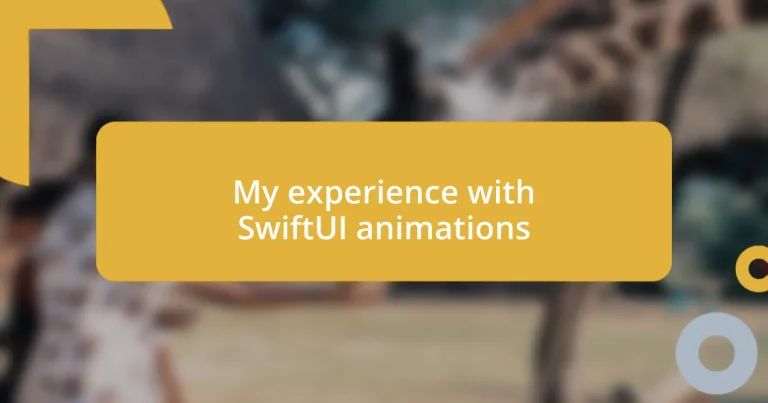Key takeaways:
- SwiftUI animations enhance user experience by adding engagement and communication through visual effects.
- Understanding the fundamentals of implicit and explicit animations, animation curves, and view modifiers is crucial for creating dynamic interfaces.
- Advanced techniques like keyframe and spring animations significantly increase creativity and realism in user interactions.
- Thoughtful use of animations can minimize cognitive load and evoke emotions, leading to higher user satisfaction.
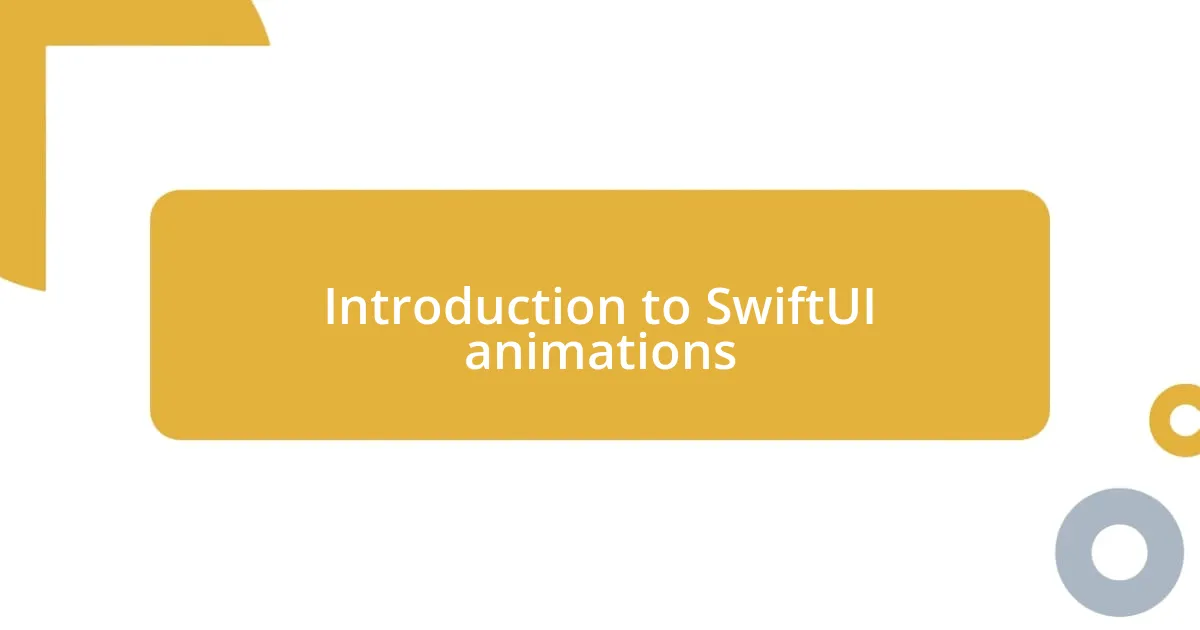
Introduction to SwiftUI animations
Diving into SwiftUI animations was a revelation for me. I still remember the first time I animated a button tap; it felt like magic watching it transform before my eyes. The simplicity of SwiftUI’s syntax, coupled with its powerful capabilities, opens up a world of possibilities for creating engaging user experiences.
What struck me most about SwiftUI animations is their ability to enhance the user interface without overwhelming the user. For instance, when I used a subtle scale effect on an image as it loaded, it not only drew attention but also made the experience feel smooth and polished. Have you ever noticed how a little animation can completely change your perception of an app? That’s the kind of impact we’re talking about.
As I delved deeper into the world of SwiftUI, I discovered that animations aren’t just about showmanship; they’re about communication. Each animation conveys a message—whether it’s indicating a change, guiding the user’s attention, or simply adding joy to the interaction. The way SwiftUI allows us to combine simplicity with expressive animations is truly fascinating; it elevates our applications from mere tools to engaging experiences that stick with the user.
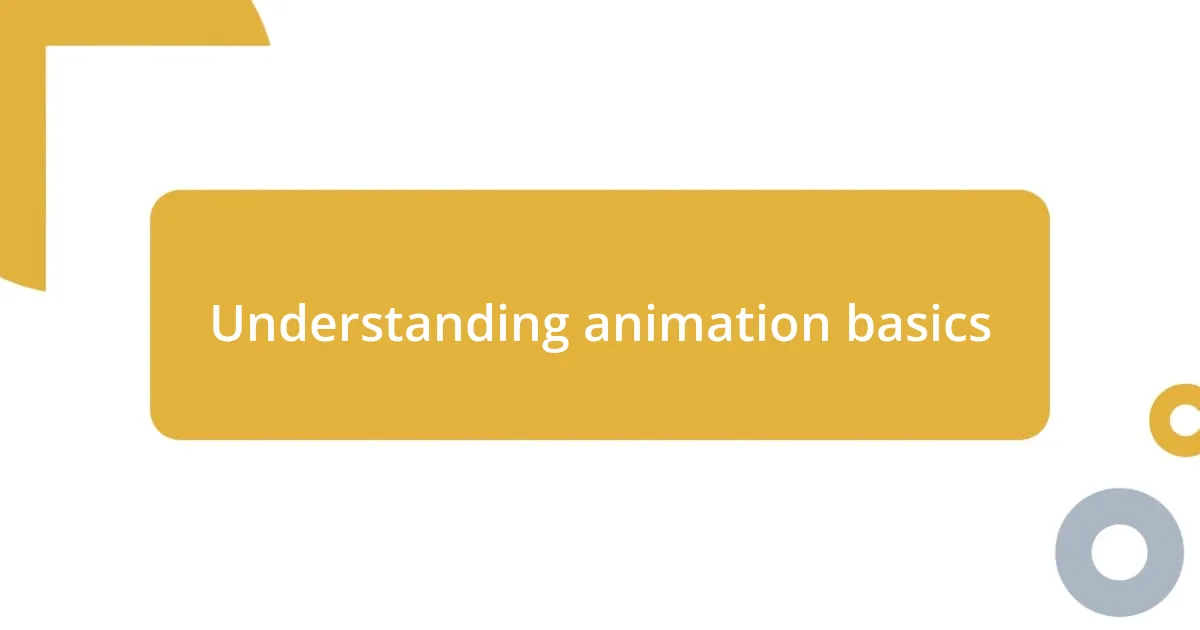
Understanding animation basics
Understanding the basics of animation in SwiftUI is foundational for creating engaging interactions. When I first started animating, I was surprised to learn that animations in SwiftUI are not just simple visual effects; they can significantly impact user engagement. For me, applying the right animations transformed my app from a static interface into a lively platform that felt responsive and dynamic.
Here are some essential concepts to grasp when learning about SwiftUI animations:
- Implicit vs. Explicit Animations: Implicit animations occur automatically when you change properties, while explicit animations require you to define their behavior.
- Animation Curves: Understanding different curves (like ease-in and ease-out) can help your animations feel more natural.
- View Modifiers: SwiftUI provides view modifiers such as
.transition()and.animation()that allow you to customize how elements enter and exit. - Timing and Duration: Experimenting with the duration of animations can influence how a user perceives the speed of the interface.
I still remember receiving feedback from users when they noticed how smoothly our navigation transitions were. It was validating to see that the tweaks I made to the animations created an experience customers appreciated. It’s one of those moments where you realize that little details really can make a big difference.
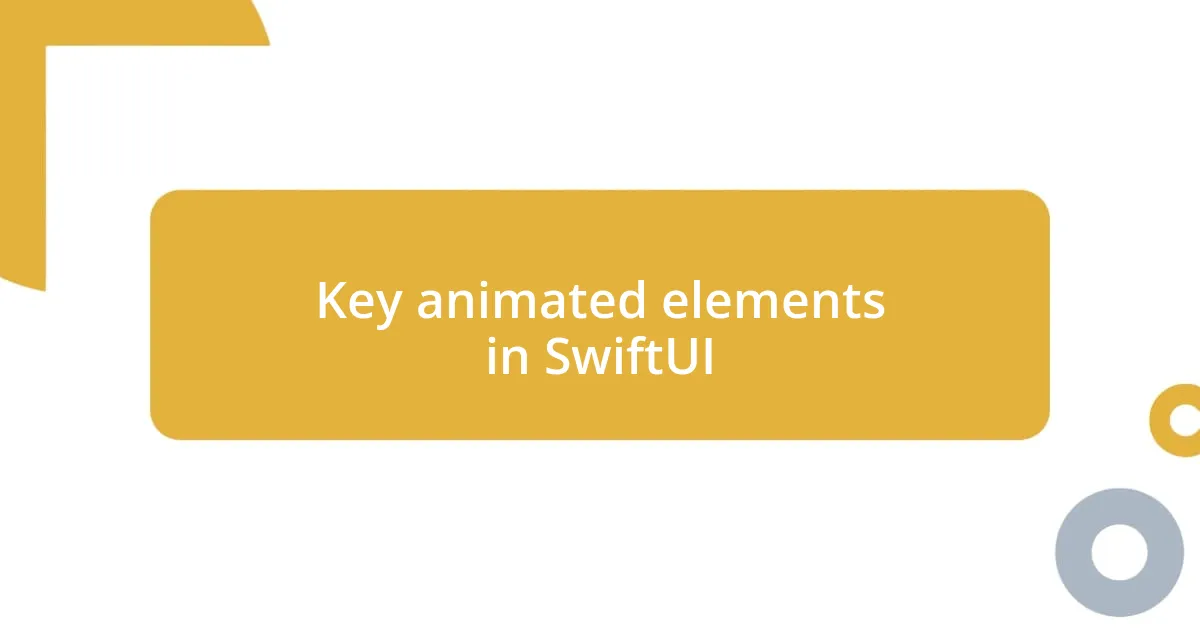
Key animated elements in SwiftUI
When I first explored the animated elements in SwiftUI, I was captivated by how easily I could make a view move, scale, or fade. The withAnimation function is a game changer; it allows you to wrap state changes and automatically enrich the user experience with animation. I was amazed at how smooth my color transitions looked. It felt rewarding—like I was adding that perfect finishing touch to my app.
Another key element I’ve enjoyed working with is the Animation struct. This powerful tool allows you to customize the timing and curves of animations, creating behaviors that feel intuitive. For example, I recall creating a playful button that would bounce when tapped. This small detail not only grabbed attention but also provided immediate feedback, making the interaction delightful. Isn’t it interesting how one little bounce can spark joy in users?
I’ve had great success with Transitions as well, which are crucial for managing view changes. I once experimented with a .slide transition that elegantly shifted a new view into place. This animation felt so natural that users often commented on how smooth the navigation felt. Just a simple effect made a significant impact. These animated elements in SwiftUI truly empower developers to create experiences that resonate emotionally with users.
| Animated Element | Description |
|---|---|
| Implicit Animations | Automatically trigger when a property changes, simplifying the animation process. |
| Explicit Animations | Require defined behaviors for animations, offering more control. |
| Animation Curves | Shapes the speed of animations, enhancing the natural feel, like ease-in or ease-out. |
| Transitions | Manage how views appear and disappear, adding smoothness to navigation. |
| View Modifiers | Customizable options that allow developers to enhance views with animations. |
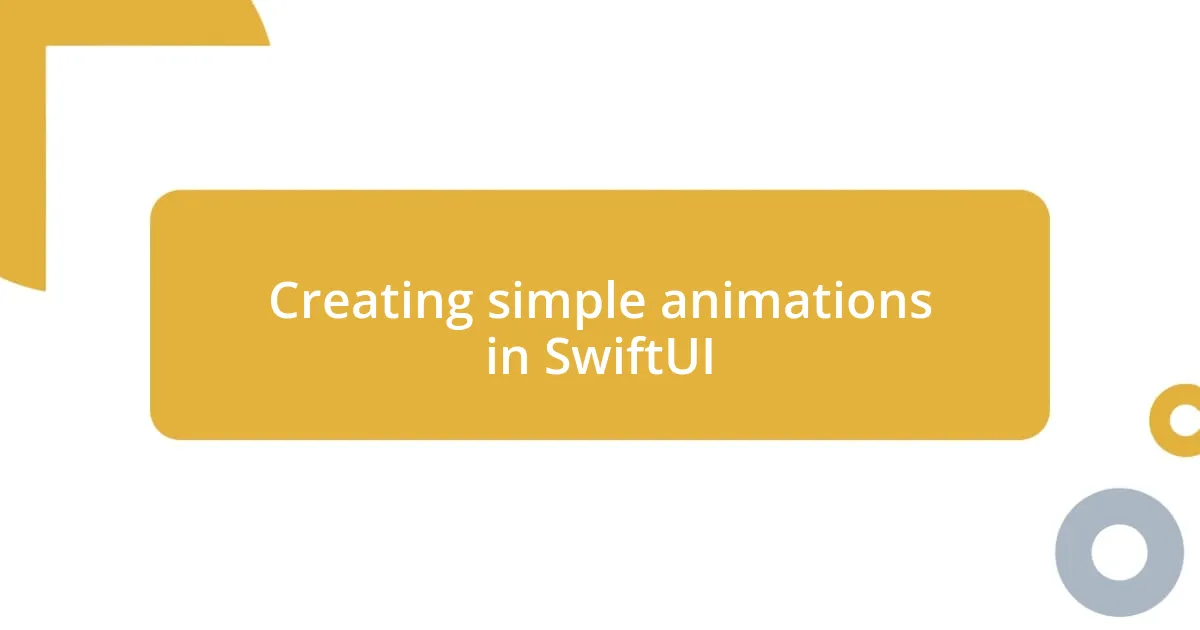
Creating simple animations in SwiftUI
Creating simple animations in SwiftUI can be a delightful experience. One of the first things I tried was a basic fade-in effect. Using the .opacity() modifier alongside withAnimation, I was amazed at how effortlessly I could make elements appear on the screen. It was like unlocking a hidden layer of interaction, and seeing a button glow into view gave me an incredibly satisfying feeling. Have you ever noticed how a small touch of animation can elevate a simple interface into something truly engaging?
What I found particularly fascinating was experimenting with implicit animations. It’s almost magical how just changing a property’s value can trigger a whole animation sequence without any extra code. I still remember the thrill of tweaking a view’s position by shifting its offset. Suddenly, my static list of items transformed into a dynamic showcase that felt interactive. It made me wonder—how much can a simple animation impact user emotions?
Another aspect I enjoyed was the timing and duration of animations. By adjusting the duration slightly, I found that I could create an entirely different mood for an interaction. For instance, when creating a transition for a loading screen, I extended the duration just enough to build anticipation without making users feel anxious. This kind of attention to detail led to positive feedback, which constantly reminds me of the importance of pacing in animation. It’s amazing how such small changes can have profound effects on user experience, right?
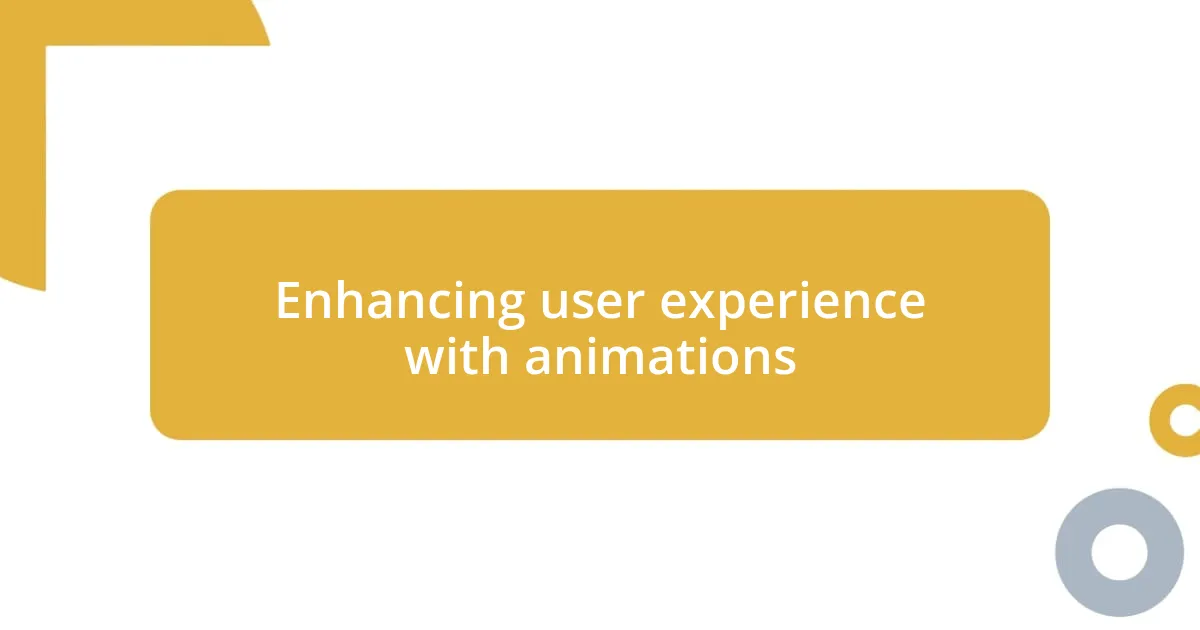
Enhancing user experience with animations
I remember the first time I integrated an animation into a app. I added a smooth scaling effect when users tapped on an item. The instant feedback was exhilarating! It instantly connected users to their action, making them feel more in control. Isn’t it incredible how a simple animation can transform a mundane interaction into a delightful one?
One area I’ve found particularly impactful is using animations to guide users through a process. In a project where I built an onboarding flow, I used a gentle slide-in effect for the steps. Watching users smoothly transition from one screen to another while gaining insights felt incredibly satisfying. I’ve noticed that such thoughtful animations can significantly minimize cognitive load. Doesn’t it amaze you how a subtle shift can create a more inviting atmosphere?
Another observation I’ve made revolves around the emotional resonance animations can generate. They have a unique power to evoke feelings, whether it’s excitement from a bouncing button or calmness from a slow fade. I once included a soft fade-out on an error message, and I could see the difference it made—users seemed less frustrated and more understanding of what went wrong. How do you think such careful considerations contribute to overall user satisfaction? It’s something I’m constantly pondering.
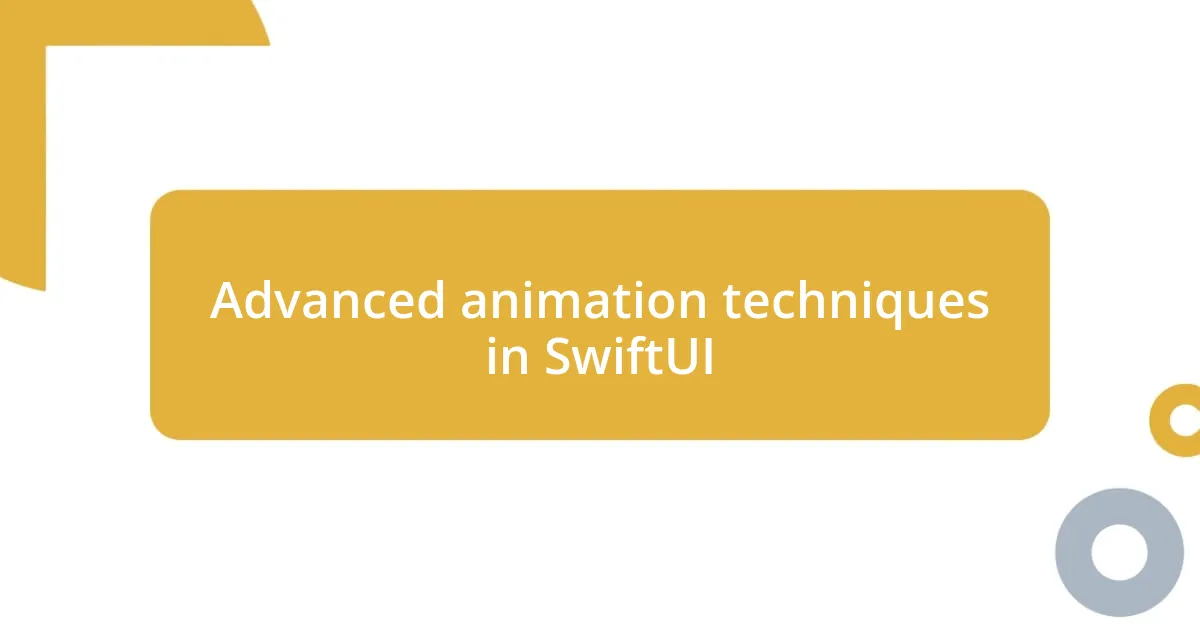
Advanced animation techniques in SwiftUI
I love diving into more advanced animation techniques in SwiftUI because they truly allow for creativity to shine through. One of my favorite techniques is using keyframe animations. They let you define specific points during an animation and adjust the properties at each frame. I remember when I implemented a spinning loading indicator—I could set different angles and scales at different keyframes. It turned what could have been a mundane wait into a visually engaging experience. Have you ever tried creating a multi-stage animation that tells a story?
Then there’s spring animations, which I found to be an absolute game-changer. The way these animations mimic the natural movement of objects can add a layer of realism to your UI. For instance, I experimented with a bouncing effect on a button press that felt so lively! The spring’s tension and damping parameters allowed me to play with how bouncy or smooth the animation felt. It’s amazing how leveraging physics in your animations can evoke joy and surprise. Wouldn’t you agree that adding a touch of realism always enhances user interaction?
Finally, I can’t overlook the power of matched geometry effects. This technique allows for seamless transitions between views, creating a cohesive user experience. I remember creating a photo gallery where tapping an image smoothly transitioned to a detailed view, making it feel like one continuous motion. It not only felt polished but also kept users engaged as they followed along. Doesn’t it feel satisfying when animations enhance navigation instead of just being decorative? When used thoughtfully, these techniques can create a narrative that keeps users engrossed.












